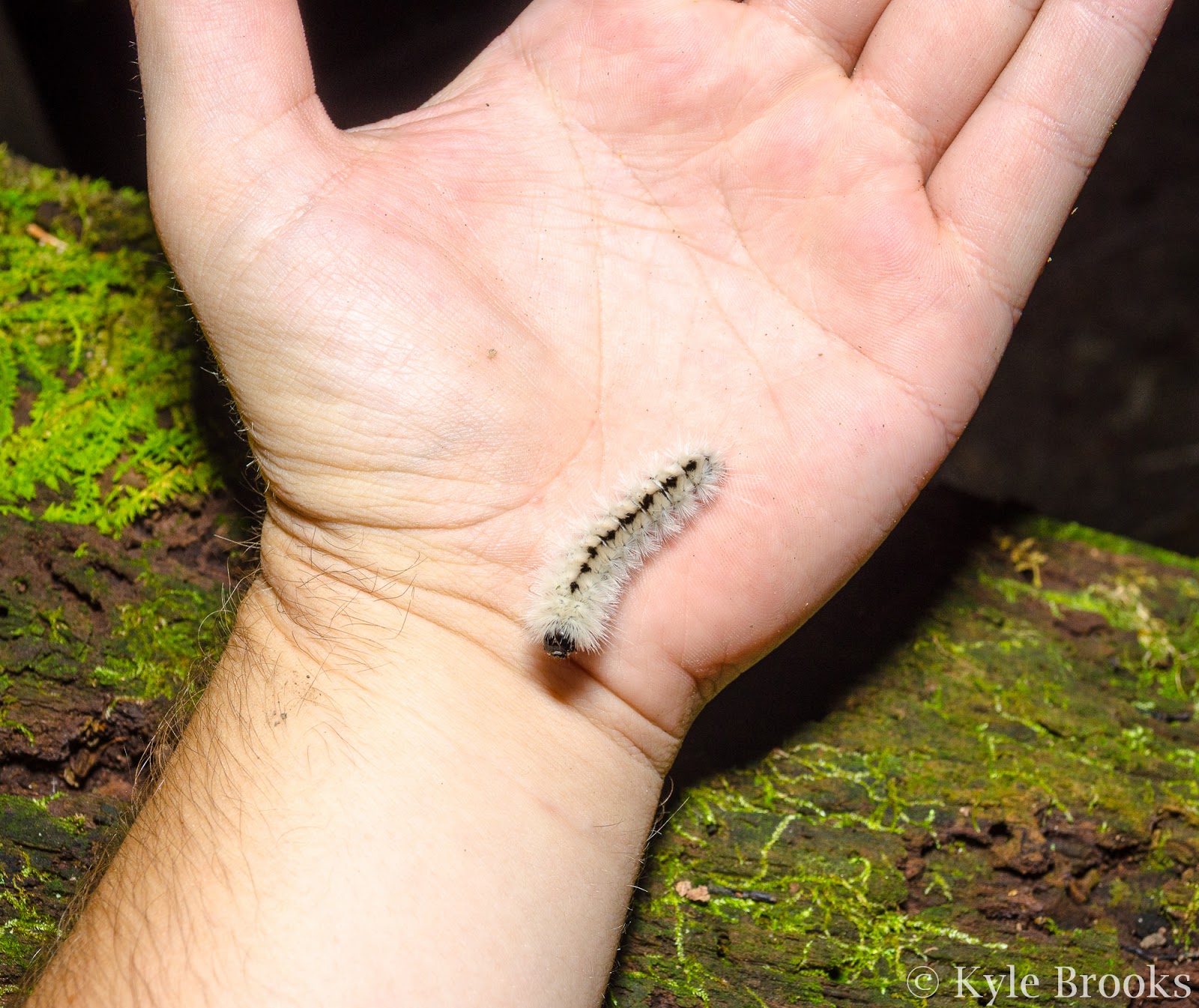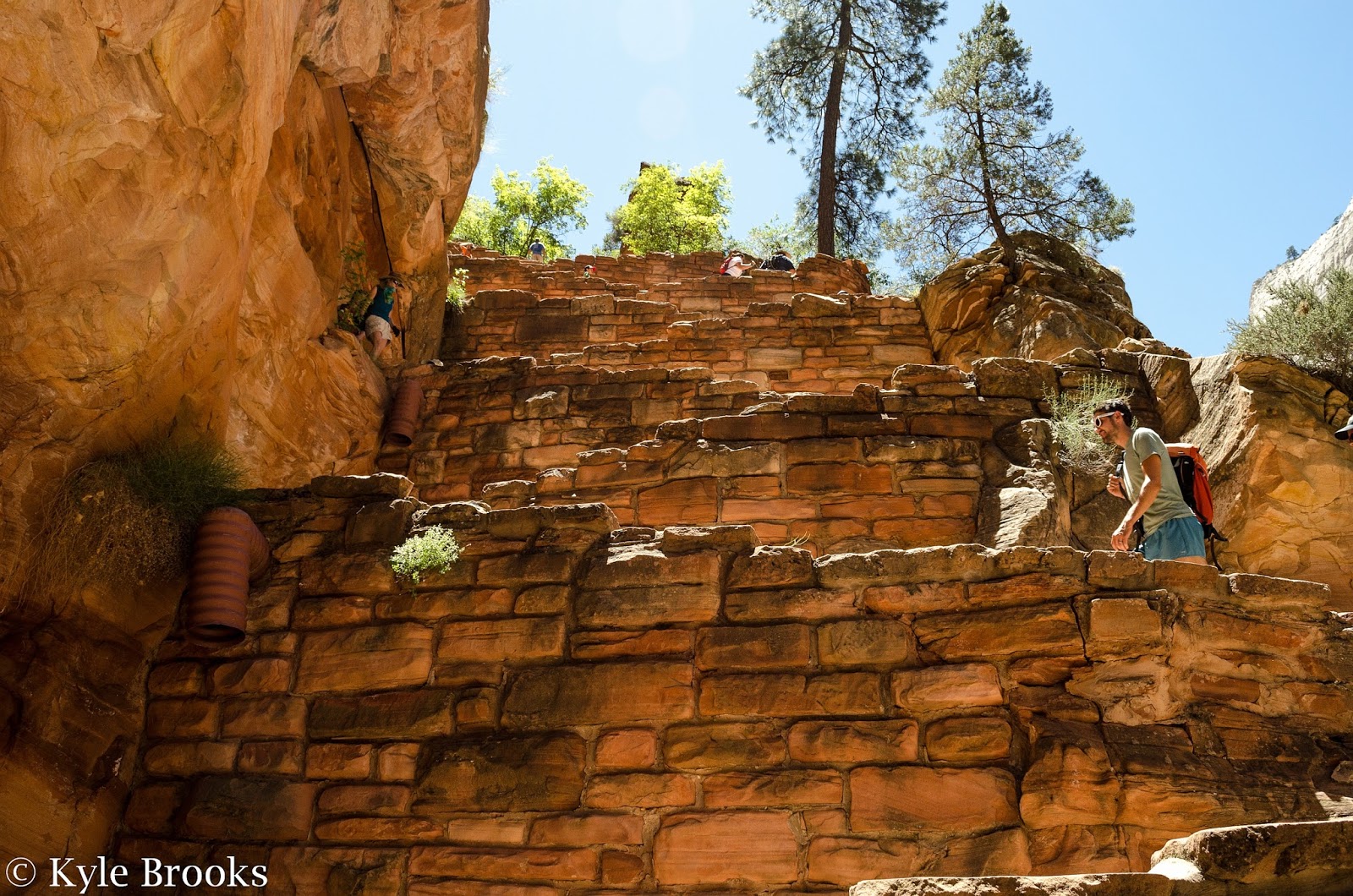I woke up early, packed up my tent, and drove the short distance from my
dispersed campsite to Springdale, Utah. With my daypack on my back, and
my trek poles in my hands, I boarded a Zion National Park shuttle bus
and rode into Zion Canyon. "Stop Number 6, The Grotto." I got off the
bus, filled my water, adjusted my poles, and started off down the trail.
As the tall Fremont Cottonwoods gave way, and the view opened up, my
eyes gazed upon the towering sandstone cathedral, so appropriately named
Angels Landing, before me.
What in the world did I get myself into.
Angels Landing is a large rock formation cut from the massive layer of Navajo Sandstone by the Virgin River. It is just one of the many features in the iconic Zion Canyon in southwestern Utah. I hiked the famous trail back in mid-July during my Arizona-to-Ohio roadtrip. This post is essentially just a pictorial journey up to the top with some fun facts and tips thrown in.
Soaring 1,488 feet above the canyon floor, Angels Landing received its appropriate name when Frederick Fisher, who was exploring the canyon with 3 others back in 1916, gazed upon the formation and claimed "Only an angel could land on it." Back then, there wasn't a trail leading to the top. Ascending Angels Landing was an incredibly difficult task and required a lot of rock climbing, and the first recorded ascent was in 1923 by park ranger Harold Russell. Although this was the first
recorded ascent, it doesn't mean this was the first time someone ever got to the top. If anyone had previously, their name is lost to history.
We humans have an insatiable urge to get on top of tall and hard to reach places, and Angels Landing is no exception. In 1926, Walter Ruesch, the park superintendent at the time, began a project to build a trail that would reach the top, allowing the visitors to the relatively-new Zion National Park to make the trek up this formidable formation. Upon completion, the trail came in at 2.4 miles from the start point to the top of Angels Landing (4.8 miles round trip). The trail starts at the Grotto Trailhead, crosses the Virgin River, and begins a gently ascending path along the canyon floor toward the wall. Upon hitting the canyon wall, a series of winding paved switchbacks (pictured above) begin. This is where the hike really kicks in.

After the first set of switchbacks, the trail rewards you with a slight respite. The trail levels out as you make your way through a much smaller side canyon called Refrigerator Canyon. The name fits quite well; the temperature in the shady canyon is much, much cooler than the exposed parts of the trail. This cool canyon offers a lower-elevation foothold for the Rocky Mountain Douglas-Fir (
Pseudotsuga menziesii var.
glauca). Typically, Douglas-Firs begin to appear around 6,000 feet above sea level in Utah, yet this canyon is about 1,000 feet lower than that. Nevertheless, the cooler temperatures allow the persistence of this cooler-weather pine.
The refreshing break of Refrigerator Canyon ends all too soon. The trail quickly arrives at the bottom of the infamous Walter's Wiggles, a section of 21 tight and steep switchbacks. The photo above shows only 9 of the 21 switchbacks, just to give you an idea. Check out
this link to see a photo of the entire section. Back and forth and back and forth you go, slowly gaining more and more elevation. This section of the trail is named after Walter Ruesch, who I mentioned a bit earlier. The creation of this section of trail allowed for hikers to reach Scout Lookout without having to climb the sandstone cliffside.

As you round the 21st switchback of Walter's Wiggles, you come to a flat, sandy area called Scout Landing. This is an area where most people take a long breather and decide whether or not to make the final push up Angels Landing. The paved trail ends here, and the remaining 500 vertical feet of your 1,488 foot climb towers in the distance. For many people, Scout Landing is far enough. I passed several people who turned around at this part of the trail. I don't blame them; looking at the final half mile of the trail made me seriously consider turning back. It looked terrifying. I knew that I would never forgive myself if I didn't finish the trail after coming this far, so I took a deep breath, calmed my nerves, and started toward the trail. And I'm so glad I did, as the trail looks much more difficult and scarier than it really is.
A word of caution: Many people like to leave their backpacks at Scout Landing before climbing up. DO NOT DO THIS. There are Rock Squirrels all over Scout Landing, and they know that humans keep food in their packs. These squirrels will chew holes into unattended packs, leaving a nice surprise for returning hikers. I passed one unattended pack with a squirrel-butt sticking out of a nice two-inch hole. Don't let that be your pack.
The final leg of the trail, up the actual Angels Landing formation, starts at...this. And yes, this is as steep as it looks. After arriving at this point, I couldn't help but utter "...seriously?" Thankfully, this was probably the most difficult part to navigate. This is the beginning of "the chains" portion of the trail. From here on up, chains were installed to help hikers make their way up more safely. These chains might offer more of a sense of safety than actual safety, however. A good rule of advice I read is that if you feel you couldn't make the hike without the chains, you probably shouldn't attempt this section.

The Angels
Landing Trail is infamous in the hiking world, and the photo above shows why. That's the trail on the left. And that's a 1,000-some foot drop, right next to the trail. There's little room for error on much of this last section, as sheer cliffsides are often only a few feet away. Add dozens of people going up and down, crowding the already narrow trail, and say hello to your adrenaline rush. The section of trail pictured above is the narrowest section in the hike. But just how narrow is it?
It's this narrow. This is a photo of me standing right on that section pictured previously. The trail is maybe 2/2.5 feet wide at most. On either side of me is a ~1,000 foot cliff. The National Park Service stresses that you shouldn't attempt this trail if you're afraid of heights, and this is exactly why. If you aren't at least comfortable with this, this trail isn't for you. You have to pay close attention to every step you take, and that becomes hard if you're overwhelmed with fear.

I took the final half mile of the trail very, very slowly. The trail can be really busy at times, and you often have to stop at a safe area and wait for groups of people to pass you either going up or down. Most of the trail is only one-person wide, so there's a lot of this stopping and starting. This is definitely not a trail to do if you're in a hurry. You can see from the photo above that the last half mile isn't actually a hike, but a rock scramble. Rock scrambling is a method of navigating up or down steep rocky terrain using both your feet and hands. It's the non-technical middle ground between hiking and rock climbing.

After 2 grueling hours and 1,488 feet in vertical elevation gain later, I stepped onto the summit of Angels Landing. It was one of the most rewarding feelings I've ever felt. Squirrels and chipmunks scampered around the exhausted hikers and stunted trees. Two Peregrine Falcons, which nest on the cliffsides, darted through the air. A lone California Condor soared by on a rising thermal.
The hike was all worth it. The views of Zion Canyon from 1,488 feet above the mighty Virgin River were astounding. This is the view from looking down the canyon.
Angels Landing is relatively far-up the wider portion of Zion Canyon. This is the view looking up the canyon. The Narrows, another incredibly famous hike, begins where the canyon walls pinch together near the center of the photo.
 |
| Looking down toward The Organ from Angels Landing. |
From atop Angels Landing, you are rewarded with a bird's-eye view of the Big Bend. Here the Virgin River lazily winds around a small rock formation named The Organ. On the other side of the river, you can see where Echo Canyon (another side canyon) joins the main Zion Canyon. The confluence of Echo and Zion Canyons is the trailhead for 3 popular hikes: Weeping Rock, Hidden Canyon, and Observation Point.
Of course, you have to get the obligatory photo of yourself while atop Angels Landing. This was personally the hardest hike I've ever done (so far), but I'm so glad I did it.
Here are a few personal tips for those considering hiking Angels Landing someday:
- Take plenty of water, and DRINK it. I knew I was going to need a lot of water, and even then I still became stupidly dehydrated. By the time I got back to Scout Landing, and the adrenaline wore off, I realized I had pretty bad heat exhaustion. It got pretty serious before I got back to the shuttle bus. You need way more electrolytes and water than you think you do.
- I highly suggest using trekking poles for the paved portion of the trail. They really help take the strain off of your legs (especially your knees while heading back down). HOWEVER, if you do use trekking poles, make sure that you can safely store them on/in your pack while doing the chains sections of Angels Landing; you'll want both hands free for this part. Using trekking poles during the last half mile adds unnecessary risk.
- Use very small steps when hiking uphill to save energy. People tend to take large steps when going uphill, but this utilizes more energy as your muscles must perform more work. Big steps equal quicker exhaustion and soreness. Take it slow, and take it small.
- There is absolutely NO shame in turning around at ANY POINT during the trail. If you feel like you can't continue, turn around. Don't risk your life. More than 5 people have died on this trail in the past few decades. This isn't a trail to mess around on.
Thanks for reading this long post! At least there were lots of photos!



























